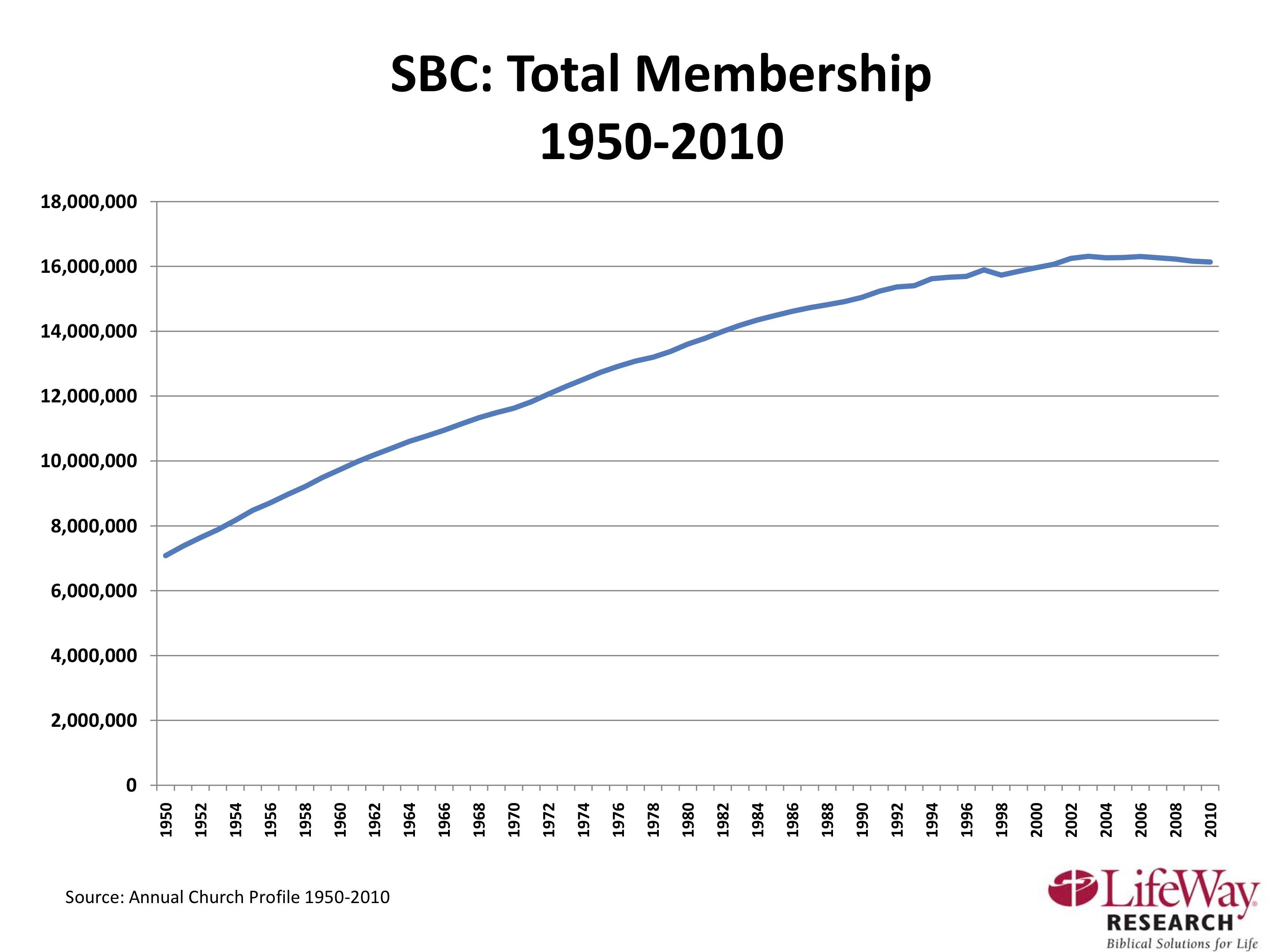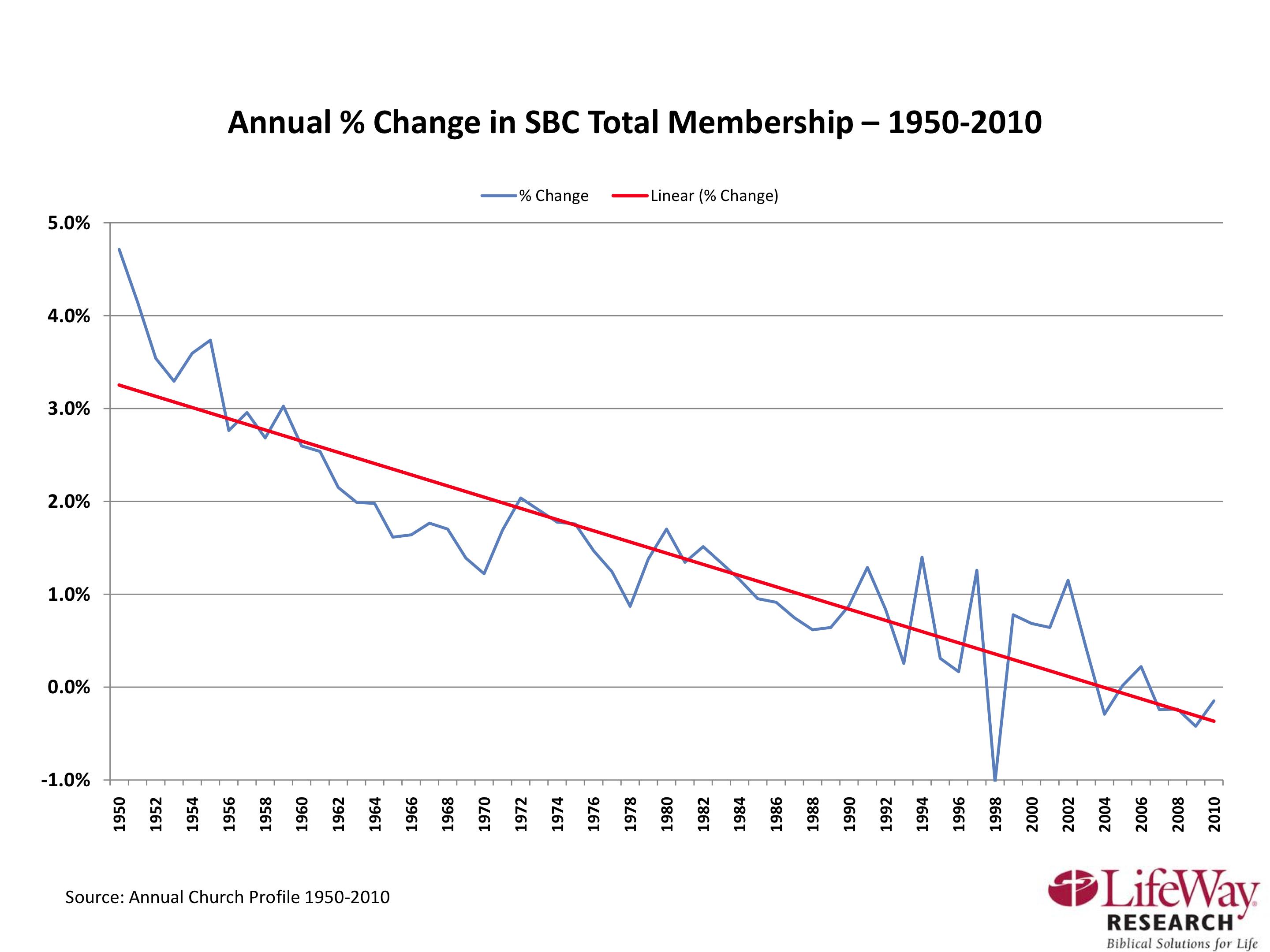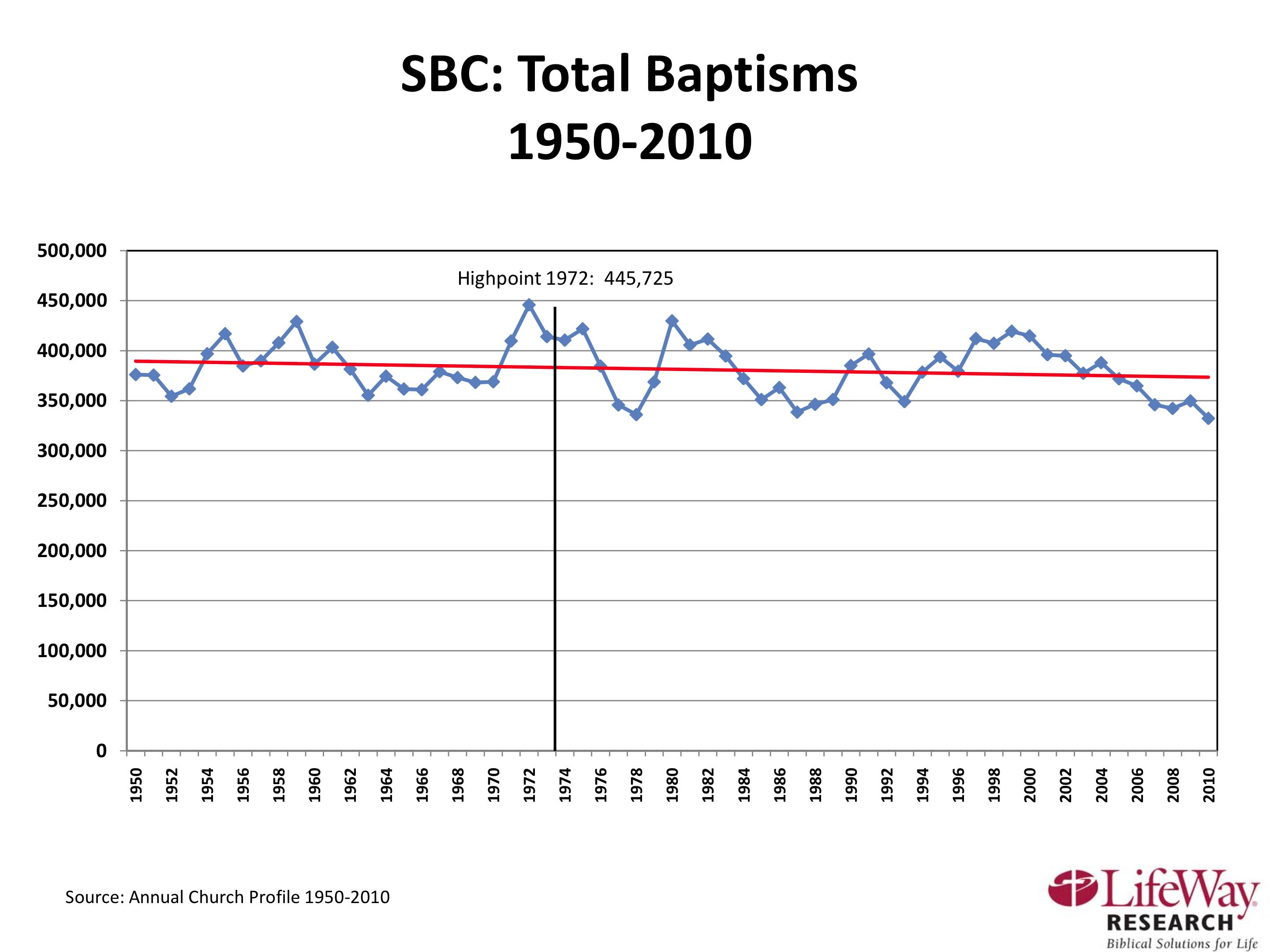
EDITOR’S NOTE: In addition to this commentary, an analysis article also is part of this posting.
NASHVILLE, Tenn. (BP)–It is time for the Southern Baptist Convention to move from denial to decision.
It has happened again. The SBC reported membership has declined, again. And, baptisms are at their lowest level in 60 years.
I remember the first time the membership declined, just a few years ago. I pointed out (based on data from LifeWay’s now-retired statistician Cliff Tharp) that it was not an aberration, but a pattern. The 50-year membership trend was moving into negative territory.
“Put simply,” I wrote in light of 2007 data, “membership may go up next year, but the trend points to the negative. It probably won’t go up. But, even if it does, I believe we will have more declining than growing years over the next decade. Unless the trend changes, membership has peaked.”
How did we respond? I remember how strongly these observations were denied. A segment of the SBC seemed to think closing our eyes or disputing the data would change our reality.
In 2008 when we were again faced with the data of a continuing trend, I noted, “Today we are facing a set of numbers to which we are not accustomed…. This year, I believe that our tipping point continues to tip. Unless things change, we are about to enter a time when we grow accustomed to decline and think back to the good ol’ days of growth.”
Following that report, there was a little less denial. Actually, more spoke up. Chuck Kelley, president of New Orleans Baptist Theological Seminary, warned that Southern Baptists are in danger of entering a deep decline with all the accompanying problems.
Subsequently, the data for 2009 revealed no reversal.
Now, we can see four years in a row of statistics confirming a long-term trend of membership decline in the SBC. It is what it is.
It is time for the SBC to move from denial to decision. I am only echoing what others have said before: It is time for change in the SBC. But change, just for the sake of change, is not enough. We must ask, “What kind of change do we need?”
For me, as a missiologist and denominational servant, change needs to come in several places.
A need for Missio Dei
First, we need a renewed passion for churches to live on mission. We need to see the church not simply as an institution but as an agent of God’s Kingdom-mission. Increasingly, people must recognize the church is a missionary body with a divine call to be a sign and instrument of God’s Kingdom. In short, God is a sending God and we are a sent people.
A need for diversity
Second, we need a greater emphasis on ethnic diversity. We’ve been so Southern and so white for so long that the annual meetings look like a loaf of Wonder Bread. Our ideas of “reaching out” are less impressive than striving to create an intentionally multicultural family that reflects the population of heaven. Simply put, denominations will not embrace ethnic leaders without a plan and strategy to do so. The SBC Executive Committee is pressing in on this issue, and it is about time.
A need for a new generation
Third, we must have a plan to raise up a new generation, not just of leaders, but young people throughout the SBC. The oldest generation may indeed be the “Greatest,” but it must not be our last. The SBC will not last forever based solely on the presence of its elder statesmen and women. Mentoring, where the younger learns from the elder, and reverse mentoring, where the elder learns from the younger, creates the kind of dynamics that perpetuate an effective denomination without the bloodletting of civil war.
A need for a renewal in church planting
Finally, we need more new churches in our convention. I’m thankful for the efforts of Kevin Ezell and the team at the North American Mission Board as they are taking bold steps to refocus on church planting. Even in the Bible Belt there are large segments of people who have not been and are not being reached with the Gospel. In our large cities one could surmise that so much “urban blight” is the result of a spiritual vacuum. In the lesser-evangelized parts of our own country are people who have been insulated from the Gospel in the most Gospel-saturated society in history. Only a vast movement of church planting across North America will see these people reached with the message of Jesus Christ.
Telling the truth has been controversial in SBC life. But facts are still our friends. The fact is, our denomination is struggling and needs to change. Yet, it is not the denomination that is “great,” rather, it is that a denomination is a family of great churches. I love those churches and pray God will use them to advance His name and His fame. The denomination is the tool the churches use to accomplish the God-given goal.
When will change come? I don’t know. Some will keep going as before — considering slow decline as acceptable as long as they can keep doing church in a way they have grown to prefer. Some are content to successfully manage decline. Yet, for others, knowing that 2010 saw the fewest number of new believers going through the baptismal waters since Eisenhower was president will break their hearts. They will weep for the lost.
We don’t change until the pain of staying the same grows greater than the pain of change. May the truth break our hearts, drive us to our knees and compel us into the mission.
–30–
Ed Stetzer is vice president of the research and ministry development division and missiologist in residence at LifeWay Christian Resources of the Southern Baptist Convention. He also has written the following analysis of the SBC statistics.
Analysis of SBC statistics
By Ed Stetzer
NASHVILLE, Tenn. (BP)–The numbers are out, again. They show decline, again. But what do they really mean?
The Annual Church Profile (ACP) numbers are actually not compiled by LifeWay Research, but are gathered by our executive communications and relations division in partnership with state conventions. We received the numbers Wednesday and decided some analysis might be helpful as we digest the changes the data reveals.
The biggest issue is a negative membership trend. As I see it, the greatest concern is not that we have 0.15 percent less members, but that it continues to reinforce a membership trend. Annual membership shifts happen regularly and have multiple causes.
Trends are what should concern us — and the one that concerns us most is the trend of membership change from year to year. A year is not a trend, but we are looking at a 50-year negative trend in regard to membership growth/decline measured year to year.
Cliff Tharp, who has written a helpful book on SBC denominational statistics, led the ACP process for 35 years. He wrote a few years ago, “We have been slowing in our growth and have now passed into decline. We are right at the top of the arc and beginning to go down. But changes we make now can change that trend significantly. These stats are not new but it has never caught anyone’s attention until now.”
The “arc” to which Cliff refers is our total membership, as shown here:
But, the 50-year trend of membership change is, in our view, the greater concern. It shows that the SBC was growing rapidly in the 1950s, growing well in the ’60s and ’70s, growing slightly in the ’80s and ’90s, and then the decline started in the new millennium. The graph tells the story:
If this 50-year trend continues (and they generally do), the small declines we see now will become big declines in the years and decades to come.
Second, the baptism trend is disturbing and now a trend of decline. For several years, LifeWay Research tried not to indicate baptisms were “trending down.” The reason for this is that shifts over a few years were not unusual over the 60-year picture. Thus, we were thinking (and hoping) that baptisms would “return to the mean,” which is a statistical way of saying they will go back to normal — and at this point that means “up.” Last year’s slight uptick gave many hope, but we sounded a cautious (though hopeful) note then.
Surely all Southern Baptists prayed this was not a trend and there would be a return to the mean. In light of last year’s data, we are forced to reconsider that view.
In our professional judgment, it is now appropriate to say SBC baptisms are on a downward trend. The large decline this year has shifted the trend line down over the last several decades (notice how it slopes to the right — it has not in past years). Thus, we must regrettably say baptisms are now trending toward decline.
We could easily create some “sensational” news with a new graph tracking baptisms since 2000. The picture would be dramatic (and truthful), but we are still hoping that this brief trend (a decade is not that long — consider 1980 to 1988 and the subsequent reversal) will change direction. But for now, SBC membership is in decline, membership change is in a 50-year decline, and baptisms are in a decade-long decline and trending down over time.
The news is not good, but God is still in charge and Southern Baptists are a wonderful people with a passion for God, His Word, and sharing Christ. I have given thoughts elsewhere on what we should do; here I simply point to where we are. Facts are our friends and these facts should concern us. Yet, as Cliff Tharp said, “Changes we make now can change that trend significantly.”
–30–



















